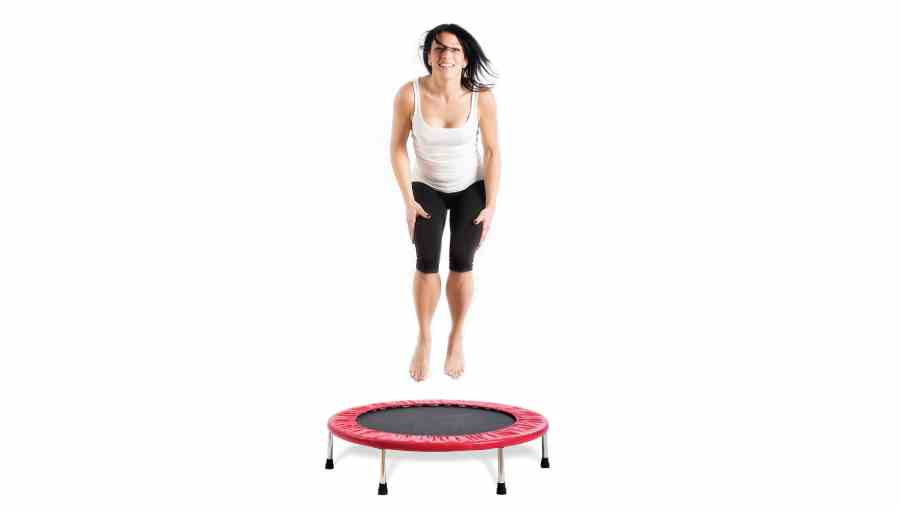J ohn P. Porcari is a bit of a reality TV show junkie. When he wants to work out, the retired professor of sports and exercise science from the University of Wisconsin-LaCrosse in the US goes downstairs and watches Alaska: The Last Frontier or Naked and Afraid while bouncing on a mini trampoline.
The global market for trampolines is anticipated to rise to $4.1 billion by 2027, up from an estimated $2.9 billion in 2020. Despite its exploding popularity — fuelled in part by the pandemic, when demand for mini trampolines skyrocketed amid gym closures — the trampoline still seems more like a kid’s toy than a legitimate workout tool. But a growing body of recent research suggests that trampolining (which is also known as rebounding) is an impressively effective and efficient mode of exercise.
Here’s what the experts say about trampoline workouts and how to get started.
Improve your balance
In addition to being a cardiovascular workout, bouncing is “fantastic” for balance, as it builds muscles in your feet, ankles and calves, Porcari said. This is particularly important as people age and their risk of falling goes up.
Another small study, published in 2011, suggested that jumping on a mini trampoline can specifically improve dynamic balance, the type of balance required when you’re walking, climbing stairs or standing in place. In older people, improving dynamic balance can lower the risk of falls.
Porcari said that even a simple routine of five or 10 minutes three days a week, alternating between jumping on one foot and two feet, can improve balance.
“Because of the relatively high intensity of trampoline exercise, you can get away with fewer minutes,” than, say, on the elliptical or treadmill, he said.
Support your pelvic floor
Trampolining may offer unique benefits for older women, who are at higher risk of developing conditions like osteoporosis and urinary incontinence than men.
One small study published in 2018 suggested that the pelvic floor muscles are highly active during mini trampoline jumping, and another, not yet published, indicates that pelvic floor function can be improved by rebounding. In that study, 37 postmenopausal women did 30-minute mini trampoline workouts three times a week. After 12 weeks, the women had better scores on urinary incontinence and higher bone mineral density. (Their bone mineral density returned to normal when they stopped rebounding regularly.)
Anja Fricke, a graduate student at Massey University in Wellington, New Zealand, and the lead author on the study, said women should start with simple jumps while holding onto a handrail if available. Start with intervals of eight minutes of bouncing followed by two-minute breaks. To get the pelvic floor muscles activated, Fricke suggested squeezing a soft gym ball or a lightweight kids’ soccer ball between the legs, then jumping by pushing off with both legs while keeping the ball in place.
Safeguard joint health
Trampolining may also be better on your joints than exercises like running, basketball or tennis, Fricke said. Much of the force of jumping and landing is absorbed by the trampoline’s elastic surface, making it easier on your joints than jumping on the ground.
“Running on a treadmill can be super hard on the joints and the knees. Doing jumps on the floor can be hard,” said Nicole Schott, a personal trainer at Future in Cranberry Township, Pennsylvania, US, who developed trampoline classes. Rebounding “allows for you to do those higher-intensity or even more complex movements without killing your body”.
Embrace your inner kid
Myriam Gilles, 51, has been rebounding since 2009 at a bouncing studio called The Ness in New York City. The 50-minute classes blend dance choreography, hand weight exercises, sit-ups and planks, all on the trampoline.
“I bounce and I SoulCycle,” Gilles said. “They’re just gentler to the body and have a community feeling that I love.”
She said trampolining also connects her to distant memories of her childhood in Brooklyn jumping double Dutch.
“I was one of those Black girls who loved to jump rope. I think there’s something about the trampoline that reminds me of that,” she said.
Get started at home
Most experts recommended a trampoline with a 32 to 48-inch jumping surface, which costs around $50. Higher-end options can cost 10 times that and may offer a more comfortable springless design, removable legs for easy transport and storage, and adjustable rubber cords, which make the device less noisy and lower impact (since rubber springs are quieter and spongier than their metal counterparts).
If you feel unsteady, experts recommend having a wall within arm’s reach or using walking poles planted on the floor beside the trampoline for balance. To make the workout harder, you can add wrist or ankle weights. Don’t get discouraged if it takes you a while to master the basics.
“Bounce incorporates balance, cardio, coordination and strength, so there is a bit of a learning curve when you begin,” said Colette Dong, co-founder of The Ness.
Here is a simple routine suitable for beginners.
Side-to-Side Hops With Feet Together: Keep a slight bend in the knees and your feet together. Hop both feet over to the other side of the trampoline and back.
Bounce-Down: Start in a squat. Begin to pulse the heels down continuously into the trampoline at a rapid rate while maintaining a squat. Then start to lift your knees in toward your centre, lifting your feet off the trampoline while keeping your body low.
High Knees: Keeping your knees slightly bent, lift one knee to your chest and alternate as quickly as you can, running in place.
Twist: Begin in a squat, with your feet slightly wider than your hips. Use your obliques to twist the lower body to one side. Swing your opposite arm forward as if you were rolling a bowling ball. Once your feet land facing one side, reverse the action to straighten the lower body.











